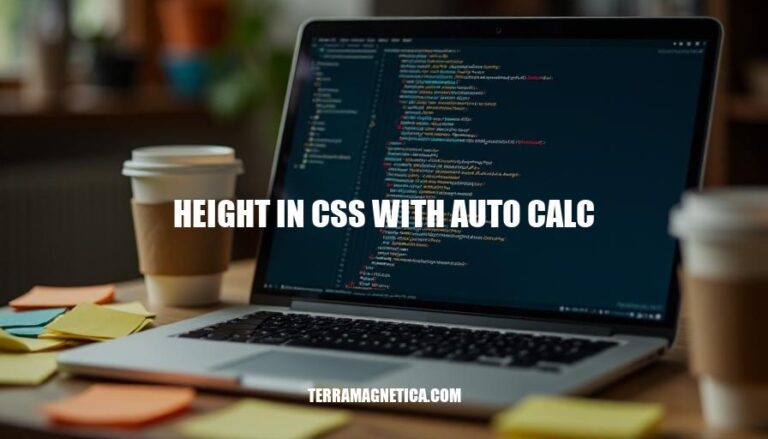


In responsive web design, using height with auto and calc() in CSS is crucial. The auto value allows elements to adjust their height based on their content, ensuring flexibility across different screen sizes. The calc() function enables dynamic calculations, such as setting an element’s height to a percentage of the viewport minus a fixed value. This combination ensures that layouts remain adaptable and visually appealing on any device.
Let’s dive into the height property in CSS and how auto and calc() can be used together.
height: auto;.container {
height: auto;
}
height: calc();.box {
height: calc(100% - 20px);
}
auto and calc().dynamic-height {
height: calc(auto + 20px);
}
In this example, calc(auto + 20px) dynamically adjusts the height based on the content and adds an extra 20 pixels.
The auto value in CSS allows an element’s height to adjust dynamically based on its content. This is particularly useful for responsive designs and elements that need to expand or collapse.
.panel {
height: 0;
overflow: hidden;
transition: height 0.25s ease-in-out;
}
.panel.expanded {
height: auto;
}
In this example, the .panel starts with a height of 0 and expands to fit its content when the expanded class is added.
<div class="accordion">
<div class="accordion-item">
<div class="accordion-header" onclick="toggleAccordion(this)">
Header
</div>
<div class="accordion-content">
Content goes here.
</div>
</div>
</div>
.accordion-content {
height: 0;
overflow: hidden;
transition: height 0.3s ease;
}
.accordion-item.active .accordion-content {
height: auto;
}
Here, clicking the header toggles the active class on the .accordion-item, causing the content to expand or collapse dynamically.
The calc() function in CSS allows you to perform calculations to determine CSS property values. However, using calc() directly with auto for height calculations isn’t straightforward because auto represents an intrinsic value that can’t be directly calculated.
To work around this, you can use JavaScript to dynamically set the height. Here’s an example:
<!DOCTYPE html>
<html lang="en">
<head>
<meta charset="UTF-8">
<meta name="viewport" content="width=device-width, initial-scale=1.0">
<title>Height Calculation with calc()</title>
<style>
.container {
overflow: hidden;
transition: height 0.5s ease;
}
.container.expanded {
height: auto;
}
</style>
</head>
<body>
<div class="container" id="container">
<p>Content goes here...</p>
</div>
<button onclick="toggleHeight()">Toggle Height</button>
<script>
function toggleHeight() {
const container = document.getElementById('container');
if (container.classList.contains('expanded')) {
container.style.height = '0px';
container.classList.remove('expanded');
} else {
container.style.height = container.scrollHeight + 'px';
container.classList.add('expanded');
}
}
</script>
</body>
</html>
In this example, the container element’s height is toggled between 0px and its scrollHeight (which is the height it would have if it were set to auto). This approach uses JavaScript to calculate the height dynamically, allowing for smooth transitions.
Here are some practical examples:
Combining auto and calc() for a flexible container height:
.container {
height: calc(100vh - 50px);
overflow: auto;
}
This sets the container height to the full viewport height minus 50 pixels, allowing it to adjust responsively.
Using calc() with auto for dynamic content sections:
.content {
height: auto;
max-height: calc(100vh - 100px);
overflow-y: auto;
}
Here, the content section will grow naturally with its content but won’t exceed the viewport height minus 100 pixels, adding a scrollbar if necessary.
Responsive sidebar with calc() and auto:
.sidebar {
height: calc(100% - 20px);
overflow: auto;
}
.main-content {
height: auto;
min-height: calc(100vh - 40px);
}
The sidebar adjusts to the full height of its parent minus 20 pixels, while the main content ensures it fills at least the viewport height minus 40 pixels.
These examples show how auto and calc() can be combined to create responsive and flexible layouts.
Here are common issues with height in CSS using auto and calc(), along with solutions:
Percentage-based calculations not working:
calc(100% - 50px) might not work as expected if the parent element’s height isn’t defined.min-height to set a base height.Flexbox and height: auto:
height: auto might not grow as expected.min-height: 0 on the flex item to allow it to shrink properly.Transitioning to height: auto:
auto can be tricky.calc() to manage transitions.Complex calculations:
calc() can lead to unexpected results.Using auto and calc() in CSS allows for dynamic height adjustments, making it ideal for responsive web design.
The auto value enables elements to grow naturally with their content, while calc() enables calculations based on other values, such as viewport height or percentages.
Common issues with using auto and calc() in CSS include:
height: auto interactionsheight: autoSolutions involve:
min-height: 0 for flex itemsBy combining auto and calc(), developers can create flexible and responsive layouts that cater to various devices and screen sizes, enhancing the user experience.